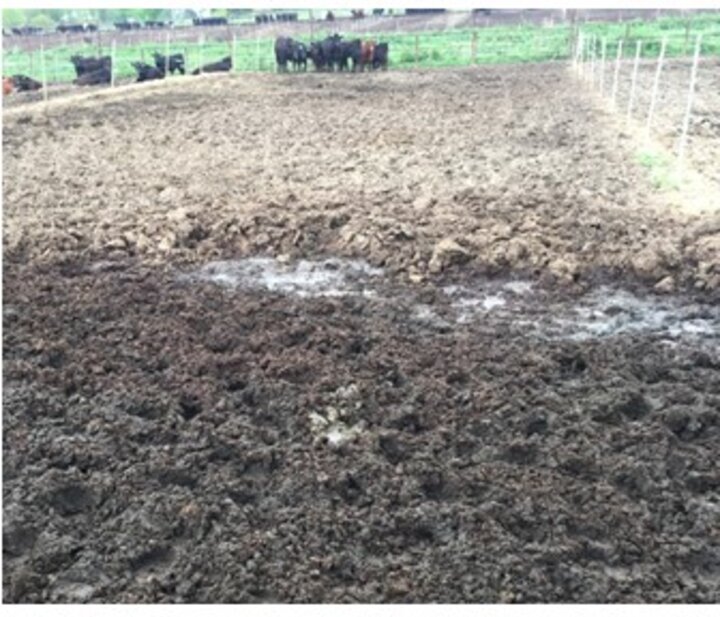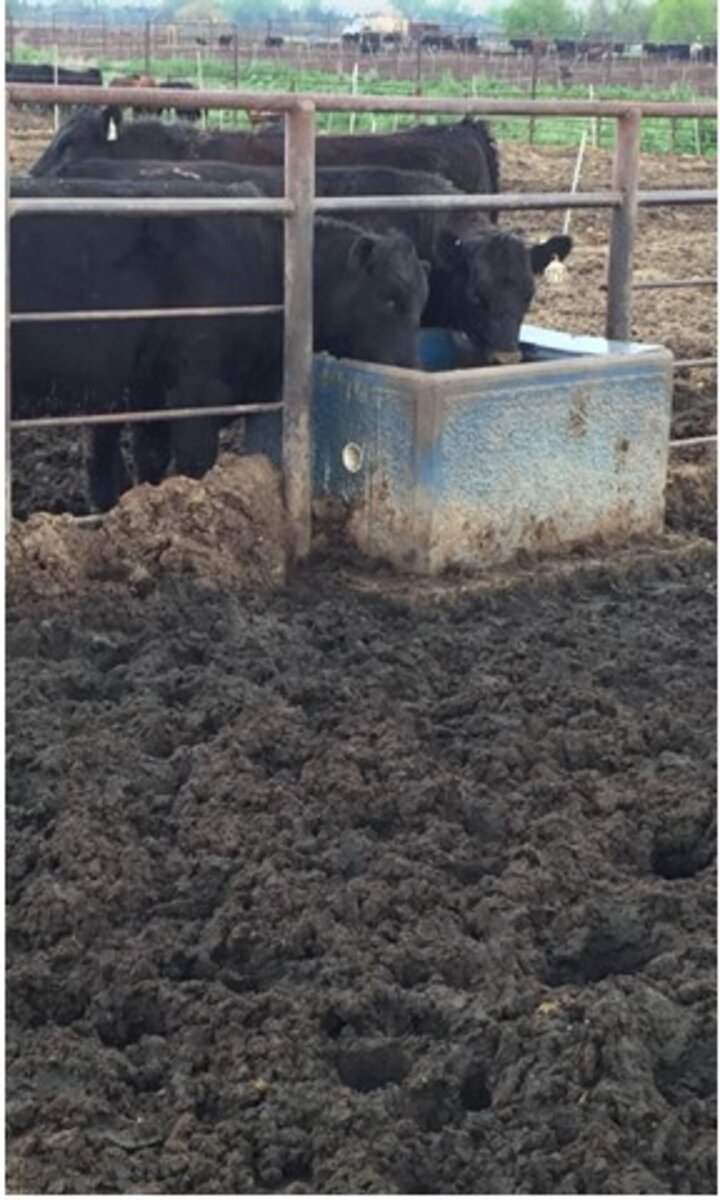Muddy Feedlot Surfaces: What Are My Options?

An undesirable combination of precipitation events and freeze/thaw cycles has contributed to some very muddy feedlot surfaces in the winter and spring of 2019 in Nebraska. These muddy surfaces contribute to poor animal performance, health issues such as foot rot, and odor issues for neighbors as temperatures warm. This article addresses some common questions about options for managing muddy feedlots.
Take-Home Message: Preventative design and management options exist for minimizing the occurrence and extent of muddy open feedlot conditions, but very few ‘fixes’ exist for addressing muddy conditions once they are in place. Getting ahead of this challenge with good feedlot design and management is the only reasonable option for avoiding the challenges that come with conditions experienced recently in much of Nebraska.
Question: What conditions should serve as a red flag of muddy lots ahead?
Answer: Wet fall and winter weather conditions are the obvious answer. Starting last fall through this winter and spring we experienced wet conditions and numerous freeze/thaw cycles of saturated feedlot surfaces. This compromised the structural capacity of the compacted soil resulting in mud everywhere.
In any year, pens that have a build-up of manure and/or standing water going into winter are more likely to experience problems with mud. These conditions further compromise the structural capacity of the compacted soil and should be a red flag over which managers should have some control.
Thus, wet fall and winter conditions may be an indication of problems ahead. An equally important red flag of future problems is limited investment in surface cleaning and maintenance.
Question: My lots are muddy; can I amend the surface to improve conditions?
Answer: There are few good solutions once lot surfaces have become very muddy. The authors’ experiences suggest that adding sand, gravel, or organic matter is not going to offer much benefit. None will likely improve the structure of the soil sufficiently to see any significant benefit. Large (2” length or greater) crushed rock is about the only amendment that has been observed by the authors to offer benefits. However, this option has the immediate expense of the crushed rock addition to the pens and the potential for additional challenges associated with foot and leg health, pen maintenance and crushed rock in the harvested manure.
Have you tried an amendment that you believe produced value? Or have you had experiences that differ from our own? If so, we invite you to share your field experience (rkoelsch1@unl.edu or rstowell2@unl.edu, 402/472-3912).
Question: What can I do to minimize the effects of mud on feedlot cattle?

Answer: Removal of snow from and frequent cleaning of the most problematic areas (e.g. region immediately behind the feed bunk and around the drinking water tanks) can help maintain acceptable conditions in these key areas. In cattle resting areas, bedding an area of 20 to 40 square feet per head was one recommendation from a study completed by Dr. Terry Mader, retired University of Nebraska-Lincoln extension feedlot specialist. When poor weather conditions persist, these strategies may become difficult to accomplish or may not produce desired lasting results.
When conditions become unacceptable in a muddy open lot, consider moving animals temporarily to an empty lot or onto a field of corn stalks to allow some lot drying and maintenance. In future years, identify in advance convenient locations within or near the feedlot with access to water, feed and fencing that can be used for temporary feeding. Temporary feeding areas can allow primary pens to receive needed maintenance and some drying during harsh winters such as experienced in 2019.
Question: Looking ahead, what practices should be done to minimize mud on open lots?
Answer: Prior to fall cattle arrival:
- Scrape the lots to maintain a 3 to 5% slope away from the feed bunk and towards the debris basin or runoff collection ditches.
- Reshape mounds and valleys to ensure that water drains away from the mounds quickly and that the animals have access to good resting area.
- Repair problem areas, especially behind the concrete pad along the feed bunk and around waterers, where pen soil tends to be eroded.
- Add soil as necessary to fill holes and rebuild mounds. Use soil that will compact, shed water, and stay in place when wetted (avoid using manure).
While cattle are being fed:
- Invest time in maintaining the pens. Clean areas behind the feed bunks and around waterers regularly. This should continue throughout the winter.
- Keep the back of the pens clean to encourage drainage. Fence lines can become an obstacle for good drainage and often require extra maintenance.
- If cleaning at the end of the feeding period is not maintaining acceptable lot conditions, consider an additional cleaning during early winter.
- Use snow fence or other seasonal barriers to reduce blowing snow from entering pens.
- Remove accumulated snow from pens. Snow may be piled at the bottom of the pens or in the runoff collection ditches, but do not create a dam that restricts pen drainage.
- If the above measures are not producing acceptable pen conditions, consider some of the options found under “Are there long-term investments that might pay dividends?”
Question: Is there research that may lead to future solutions?
Answer: USDA Meat Animal Research Center scientists have investigated using coal ash materials as a pen surface. Some coal-fired, electrical generation plants temporarily dispose of fly ash in ponds when they can’t sell or dispose of it immediately. The fly ash is water activated and goes through cementation, meaning it will harden if it is allowed to dry. This ash material (pond ash) is excavated and use for multiple purposes. MARC scientists used the pond ash as a feedlot pen surface. The ash particles resulting from the combustion process provided structural support somewhat independent of water content and allowed drainage of the pen surface. MARC’s experience working with pond ash was that it provided a stable pen surface that drained well. They surfaced several small pens and evaluated them for three years. The results were a 70% reduction in erosion, leading to less soil in the collected manure, and the surface dried much quicker without pot holes to hold water when it rained. In other words, it shed water much better and provided a superior surface for animal well-being and pen maintenance.
Warning: The ash is whatever is left after combustion and can contain a lot of contaminants (i.e. metals) that can leach from the surface and enter the environment. Given the spatial and temporal variability of the ash excavated from the generation plant ponds, testing for contaminants beforehand wouldn’t be effective. Also, there have been discussions about classifying all coal ash materials as hazardous. Given these uncertainties, MARC suspended this research and this is not a recommended practice at this time.
Question: Are there long-term investments that might pay dividends?
Answer: Here are a few options for your consideration to enhance feedlot pen conditions:
- Expand the concrete pad behind the feed bunk and around the waterers. Typically, concrete pads are 8 to 12 feet wide. Pad widths of 12 to 16 feet and concrete connecting the feed bunk pad to the waterers are recommended to maintain more desirable pen conditions.
- Shape pens to include mounds and valleys. Ideally a 3 to 5% slope away from the feed bunks and mounds should be maintained. Mounds should be built from clay soils and limestone can be incorporated to reduce water retention. Minimize use of manure in mound construction and maintenance. Valleys should be located on both sides of the mound and between the mound and fence.
- Provide additional pen space. Providing 250 square feet or more per head of capacity improves pen conditions in more-humid areas like eastern Nebraska. Caution: Larger pens also collect more runoff, so consider the full environmental/economic picture.
- Plant shelterbelts to manage blowing snow and minimize its immediate and longer-term effects on the feedlot.
- Landscaping can also reduce odor and dust challenges downwind of muddy lots. Trees and shrubs encourage the odor plume to be stirred and vertically mixed by forcing air over and through the vegetative barrier. This helps to dilute and disperse odors to higher elevations and reduce neighbor exposure. Gravitational settling of dust, a carrier of odors, occurs in the ‘quiet zone’ directly downwind of vegetation, much like snow behind a snow fence, and reduces neighbors’ exposure.
Siting of windbreaks must consider prevailing wind directions for your specific location in Nebraska. It is extremely important to keep open lots exposed to summer breezes, as this airflow is critical to managing heat stress in feedlot cattle.
Additional Reading:
Veterinary and Animal Science. Evaluation of the welfare of cattle housed in outdoor feedlot pens. Author: Temple Grandin.
USDA. “Windbreak Plant Species for Odor Management”. Authors: Shawn Belt and others.
Nebraska Forest Service. “Windbreaks for Livestock Operations”. Authors: Vernan Quam and others.
MidWest Plan Service. “Controlling Dust and Odor from Open Lot Livestock Facilities”. Author: Brent Auvermann.
University of Nebraska, Lincoln, “Mud Effects on Feedlot Cattle”. Author: Terry Mader.
Nebraska Extension. Planning a New Cattle Feedlot. Authors: Chris Henry and others.
This article was reviewed by Ben Beckman, Nebraska Extension Educator; James McDonald, Associate Professor, University of Nebraska-Lincoln